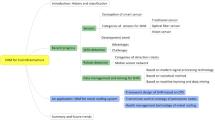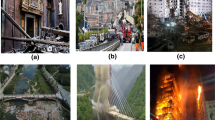Abstract
Structural health monitoring (SHM) plays a key role in the modern civil engineering inspection methods. Rapid developments of both small-scale and large-scale infrastructures around the world demand for efficient and timely inspection. With the advances in the field of information technology (IT), a myriad of opportunities has emerged to improve the basic design of the current SHM systems. However, in the real-world scenario, design and development of a robust SHM system face several challenges. This paper identifies such unexplored and yet essential issues that should be tackled to build SHM systems for today’s world. This paper also highlights the existing major techniques used in performing SHM on the already built and under construction infrastructures as well as proposes a novel wireless sensor network-based SHM system aimed at reducing the cost of data storage and processing, improving the security of the data and better user interface for the engineers/inspectors for apposite monitoring and control of the structure’s health parameters.



Similar content being viewed by others
Data availability
This paper does not utilizes any experimental data.
Change history
26 April 2023
A Correction to this paper has been published: https://doi.org/10.1007/s42107-023-00608-2
References
Abdel-Qader, I., et al. (2003). Analysis of edge-detection techniques for crack identification in bridges. Journal of Computing in Civil Engineering, 17(4), 255–263.
Boscato, G., et al. (2019). Structural health monitoring through vibration-based approaches. Shock and Vibration, 2019, 1–5.
Coskun, V., et al. (2013). A survey on near field communication (NFC) technology. Wireless Personal Communications, 71(3), 2259–2294.
Deraemaeker, A., et al. (2008). Vibration-based structural health monitoring using output-only measurements under changing environment. Mechanical Systems and Signal Processing, 22(1), 34–56.
Derriso, M. M., et al. (2016). A novel approach for implementing structural health monitoring systems for aerospace structures. In Structural health monitoring (SHM) in aerospace structures (pp. 33–56). Elsevier.
Farrar, C. R., & Worden, K. (2007). An introduction to structural health monitoring. Philosophical Transactions: Mathematical, Physical and Engineering Sciences, 365(1851), 303–315.
Farrar, C., Hemez, F., Shunk, D., Stinemates, D., & Nadler, B. (2004). A review of structural health monitoring literature: 1996–2001. Los Alamos National Laboratory
Fritzen, C. P. (2005). Vibration-based structural health monitoring—Concepts and applications. Key Engineering Materials, 293–294, 3–20.
Gautam, S., et al. (2018). A study of bluetooth wireless technology using recent attacks. International Journal of Advanced Research in Computer Science and Software Engineering, 8(4), 42.
Güemes, A., et al. (2018). Structural health monitoring in composite structures by fiber-optic sensors. Sensors, 18(4), 1094.
Hai, B. S. M. E, & Markus, B. (2014). Finite element model-based structural health monitoring (SHM) systems for composite material under fluid-structure interaction (FSI) effect. Hal.inria.fr. https://hal.inria.fr/hal-01021185. Accessed 20 Nov 2022.
Kaveh, A., & Dadras, A. (2019). An efficient two-stage method for optimal sensor placement using graph-theoretical partitioning and evolutionary algorithms. Structural Control and Health Monitoring, 26(4), e2325.
Kaveh, A., Eslamlou, A. D., Rahmani, P., & Amirsoleimani, P. (2022). Optimal sensor placement in large-scale dome trusses via Q-learning-based water strider algorithm. Structural Control and Health Monitoring. https://doi.org/10.1002/stc.2949 First published: 02 March 2022.
Lim, R. S., et al. (2014). A robotic crack inspection and mapping system for bridge deck maintenance. IEEE Transactions on Automation Science and Engineering, 11(2), 367–378.
Livitsanos, G., et al. (2020). Numerical simulation of elastic wave propagation in masonry compared with acoustic emission experimental results. Archives of Civil and Mechanical Engineering, 20(1), 17.
Lopez-Higuera, J. M., et al. (2011). Fiber optic sensors in structural health monitoring. Journal of Lightwave Technology, 29(4), 587–608.
Lynch, J. P. (2007). An overview of wireless structural health monitoring for civil structures. Philosophical Transactions of the Royal Society a: Mathematical, Physical and Engineering Sciences, 365(1851), 345–372.
Ou, J., & Li, H. (2009). Structural health monitoring research in china: trends and applications. In Structural health monitoring of civil infrastructure systems (pp 463–516). Elsevier.
Park, G., et al. (1999). Impedance-based structural health monitoring for temperature varying applications. JSME International Journal Series A, 42(2), 249–258.
Park, S., et al. (2008). Structural health monitoring using electro-mechanical impedance sensors. Fatigue & Fracture of Engineering Materials & Structures, 31(8), 714–724.
Qing, X., et al. (2019). Piezoelectric transducer-based structural health monitoring for aircraft applications. Sensors, 19(3), 545.
Ramya, C. M., Shanmugaraj, M., & Prabakaran, R. (2011). Study on ZigBee technology. In 2011 3rd International conference on electronics computer technology, Kanyakumari (pp. 297–301). IEEE.
Sensors for structural health monitoring. Available online. Accessed 15 July 2020.
Shukla, A., Verma, R., Kandasamy, J., et al. (2019). Recent advances and trends in structural health monitoring. In Structural health monitoring of biocomposites, fibre-reinforced composites and hybrid composites (pp. 53–73). Elsevier.
Sinha, R. S., et al. (2017). A survey on LPWA technology: LoRa and NB-IoT. ICT Express, 3(1), 14–21.
Ye, X. W., et al. (2016). A review of machine vision-based structural health monitoring: methodologies and applications. Journal of Sensors, 2016, 1–10.
Funding
This research was funded by the MNNIT-Allahabad research fund.
Author information
Authors and Affiliations
Contributions
This work is carried out in collaboration between both authors. SS performed a detailed study and managed the literature searches to write the first draft of the manuscript in consultation with RS. All authors have read and agreed to the published version of the manuscript.
Corresponding author
Ethics declarations
Conflict of interest
The authors declare no conflict of interest.
Additional information
Publisher's Note
Springer Nature remains neutral with regard to jurisdictional claims in published maps and institutional affiliations.
The original online version of this article was revised: the email address of author Rama Shanker was not correct
Rights and permissions
Springer Nature or its licensor (e.g. a society or other partner) holds exclusive rights to this article under a publishing agreement with the author(s) or other rightsholder(s); author self-archiving of the accepted manuscript version of this article is solely governed by the terms of such publishing agreement and applicable law.
About this article
Cite this article
Singh, S., Shanker, R. Development of a robust structural health monitoring system: a wireless sensor network approach. Asian J Civ Eng 24, 1129–1137 (2023). https://doi.org/10.1007/s42107-022-00537-6
Received:
Accepted:
Published:
Issue Date:
DOI: https://doi.org/10.1007/s42107-022-00537-6




